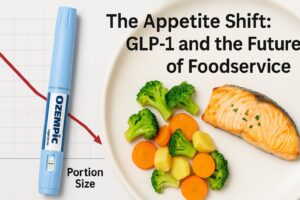A Convergence of Two Powerful Forces
Inflation and appetite suppression may seem unrelated, yet both are reshaping the way Americans approach food. Over the past two years, inflation has altered the rhythm of restaurant visits, meal occasions, and operator margins. Now, with millions of prescriptions written for GLP-1 drugs such as Ozempic and Wegovy, a subtler question is emerging: if fewer consumers feel hungry, how might that influence what—and how much—they order?
At Foodservice IP, we caution that there is no measurable decline in away-from-home dining directly tied to GLP-1 use. Most of the evidence remains anecdotal or survey-based, concentrated within packaged foods. Still, the idea of appetite reduction is already seeping into industry planning. The possibility of smaller portions, slower consumption, and new definitions of value is forcing restaurants, distributors, and manufacturers to think differently about growth.
Beyond the Hype: What the Data (and the Silence) Tell Us
To date, no major chain or distributor has reported a GLP-1-driven drop in traffic. Restaurant visits continue to track economic conditions more than medical ones. In FSIP’s recent outreach to national and regional operators, most leaders described inflation and labor costs as their primary concerns, not appetite shifts.
Yet nearly half said they have begun monitoring portion waste, ticket mix, and beverage attachment rates “more closely than ever.” One casual-dining executive put it succinctly:
“We haven’t seen sales fall off because of Ozempic, but we’re watching the signs—smaller checks, more substitutions, fewer desserts. Even if it’s just perception, it changes how you plan menus.”
That perception alone can influence investment. History shows that the foodservice industry often adjusts to expectations faster than to evidence.
Commercial Foodservice: Smaller Plates, Higher Stakes
In the restaurant sector, adaptation is happening through incremental adjustments rather than bold pivots. Operators are experimenting with protein-dense entrées, lighter combinations, and beverage lineups that promise hydration or functionality instead of pure indulgence.
Quick-service brands are testing smaller wraps and snackable formats that preserve value perception while trimming calories. Full-service concepts are quietly re-engineering menu architecture—pairing higher-margin, premium ingredients with reduced portion sizes. Convenience-store foodservice, meanwhile, may be an unexpected winner: its portion-flexible, grab-and-go model aligns neatly with consumers who want control without commitment.
The key challenge remains price architecture. Smaller portions can’t simply mean smaller checks; consumers must see quality, freshness, or functionality as the new justification for value.
Non-Commercial Foodservice: The Early Indicators
Outside traditional restaurants, the signals may appear first. Healthcare, senior living, workplace dining, and higher-education programs already serve as laboratories for portion control and nutritional precision.
In FSIP’s recent conversations with hospital and senior-living directors, many report rising demand for smaller but protein-rich meals—a trend accelerated by medical guidance and patient feedback, not just GLP-1 adoption. One director noted,
“Our residents want flavor, but half of them now leave part of the entrée. We’re redesigning menus to waste less and satisfy faster.”
For K-12 and higher-education dining, participation and waste metrics could become the most revealing early data. If calorie consumption modestly declines among faculty or older students, menu planning will need to emphasize nutrient density and appeal within smaller footprints.
Manufacturers and Distributors: Prepare, Don’t Pivot
For suppliers, GLP-1 awareness reinforces trends that were already underway. Smaller pack sizes, portioned snacks, and higher-protein offerings continue to outperform in retail, and those cues are migrating into foodservice product development. Manufacturers should, however, avoid treating GLP-1 as a fad.
Instead, FSIP recommends scenario planning across three demand pathways:
Indulgence Recovery – traditional comfort and value regain strength as inflation eases.
Moderation Mainstream – consumers normalize smaller portions and protein-forward choices.
Health-Dominant Shift – functional and medically aligned foods become the default expectation.
Each scenario requires flexible sourcing, adaptable packaging, and a balanced message. Overreacting could alienate core users who still equate value with abundance.
Co-manufacturing and commissary networks may benefit if operators seek tighter control of portioning or reformulation. Likewise, distributors could see opportunity in SKU rationalization—fewer supersized items, more right-sized cases that reduce spoilage and align with smaller menu builds.
Economic and Behavioral Realities
From a behavioral-economics lens, GLP-1 introduces a fascinating tension: consumers who can afford to dine out may physically desire less food, while those most constrained by inflation still want indulgence but ration frequency. That duality forces operators to address both ends of the satisfaction curve—emotional and biological hunger.
As one fast-casual operator told FSIP,
“The appetite might shrink, but people still want an experience. That’s where we can win.”
That insight may prove the most important: GLP-1 doesn’t eliminate demand; it reframes what “enough” feels like.
The FSIP Takeaway
GLP-1 may not shrink the pie—but it could change how it’s sliced.
At present, the data show little direct impact on foodservice traffic. Still, perception and preparation matter. The smartest companies are quietly stress-testing menus, portioning, and product portfolios for a future in which moderation, health, and value coexist.
Whether appetite suppression becomes a macro-trend or remains a niche behavior, the outcome will favor those who view adaptability not as a response, but as a strategy.
To learn more about FSIP’s Management Consulting Practice, click here.
Like the content? Sign up to receive our communications.

Recent Comments